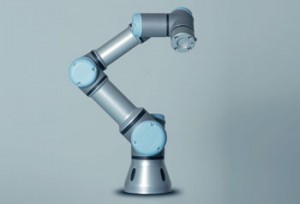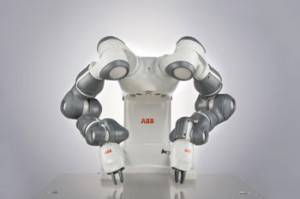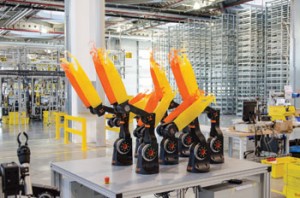On the cusp of a revolution in collaborative robotics
 Anyone looking at the robotics offerings at this year’s Hannover Fair can’t fail to have noticed all the activity surrounding collaborative robots – not least because two significant acquisitions happened at just about the same time. First ABB bought Gomtec, and then Universal Robots announced that it had agreed an acquisition by Teradyne. If we hadn’t realised already, these two acquisitions signalled that the world of collaborative robotics really was becoming big business.
Anyone looking at the robotics offerings at this year’s Hannover Fair can’t fail to have noticed all the activity surrounding collaborative robots – not least because two significant acquisitions happened at just about the same time. First ABB bought Gomtec, and then Universal Robots announced that it had agreed an acquisition by Teradyne. If we hadn’t realised already, these two acquisitions signalled that the world of collaborative robotics really was becoming big business.
In this new and exciting world, robots freed from their traditional guarded environments will work along side human operatives, defining a new paradigm of productivity on lines across the spectrum of industries. Forget the goliaths of the automotive industry capable of handling huge weights with ease, these are smaller robots adept at handling the smallest of parts. They are easy to integrate, easy to program and safe to work alongside. And they come at a cost that make them affordable for just about any business.
If any company can lay claim to have created the market for collaborative robots, then it must sure be Danish manufacturer Universal Robots. With its three-robot range (the UR10, UR5 and benchtop UR3), the company achieved record growth in 2014, with revenue increasing 70% over 2013 to reach more than $38 million, and profit more than doubling from the prior period. Universal Robots estimates the collaborative robots market to be worth some $100 million, and growing at more than 50% a year. That is borne out by the fact that Teradyne will reportedly pay $285 million for the company, plus a further $65 million if certain performance targets are met.
195 day payback period
The huge attractions of the Universal Robots products have been their combination of price, purpose and ease of programming. The company often quotes an average payback period of around 195 days, depending on the specific product and configuration. That makes it something that’s readily affordable for most businesses. Programming is easy, too. But perhaps most significantly, these robots can work alongside people without the need for guards, being designed safe.
“That combination of features makes the Universal Robots product ideal for SMEs,” says Peter Williamson, managing director of UK distributor RA Rodriguez. “Sales in the UK are beginning to grow as more companies see what it can do. Once a robot is installed, confidence grows quickly – seeing is believing.”
 Universal Robots does not have the market to itself. Perhaps the highest profile alternative is YuMi from ABB. This made its debut at the 2014 Hannover Fair, but it is only this year that pricing has been confirmed at around $40,000 for a fully collaborative, dual-arm robot. Lead-through programming allows the robot to be taught to complete tasks by operators by simply moving its arms.
Universal Robots does not have the market to itself. Perhaps the highest profile alternative is YuMi from ABB. This made its debut at the 2014 Hannover Fair, but it is only this year that pricing has been confirmed at around $40,000 for a fully collaborative, dual-arm robot. Lead-through programming allows the robot to be taught to complete tasks by operators by simply moving its arms.
Extending its scope further within the fast growing collaborative robotics market, ABB announced that it was buying Gomtec, whose Roberta collaborative robot created something of a stir at last year’s Hannover Fair. Seemingly Roberta complements YuMi by expanding capabilities into higher payload applications, with YuMi focused primarily on areas such as handling smaller parts. “We are seeing an increasing trend of automation innovation where humans and robots work side-by-side in ways that weren’t possible before,” said Pekka Tiitinen, president of ABB’s discrete automation and motion division. “The addition of Gomtec to our robotics offering will help accelerate ABB’s expansion into new markets as well as our penetration of traditional industries as manufacturers pursue new ways to increase flexibility, agility and competitiveness.”
Collaborative robots at attractive prices
There are other collaborative robot offerings from the likes of Rethink Robotics with its Baxter product and Kuka with the LBR iiwa. All focus on the combination of the capabilities and the attractive price.
 But how low can the price go? According to Justin Leonard, director at Igus, a key focus for a number of manufacturers is the £1000 robot, and Igus may just have stolen a march on the competition. Another key introduction at the 2015 Hannover Fair was the Igus’ Robolink D, a direct driven update of the original Robolink. The moving joints are based on Igus’ PRT slewing ring bearings, with prefitted motor technology and easy-to-use Wago control kit.
But how low can the price go? According to Justin Leonard, director at Igus, a key focus for a number of manufacturers is the £1000 robot, and Igus may just have stolen a march on the competition. Another key introduction at the 2015 Hannover Fair was the Igus’ Robolink D, a direct driven update of the original Robolink. The moving joints are based on Igus’ PRT slewing ring bearings, with prefitted motor technology and easy-to-use Wago control kit.
Robolink D is not yet an off-the-shelf product, and in typical style Igus is keen to do a lot of testing to really prove the technology. But certainly any interested parties who wanted to work with the company in the development could see Robolink D robots on their lines pretty quickly. By targeting a price of £1000, Igus is making a statement. “Nobody has yet addressed the low cost end of the robotics market, but there could be very high volume here,” says Leonard. “We see a gap in the market and we see a hunger for the product.”
For more information, visit the Universal Robots website, the RA Rodriguez website, the ABB Robotics website, the Rethink Robotics website, the KUKA website and the Igus website.
See all stories for:















